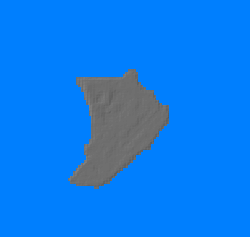![]() The Pacific War Online Encyclopedia
The Pacific War Online Encyclopedia
|
| Previous: Andromeda Class, U.S. Attack Cargo Ships | Table of Contents | Next: Anhwei |
 |
U.S. Army. Via ibiblio.org |
Angaur (134.14E
6.90N) is a small island in the Palau
group. Some 2-1/4 miles (3.6 km) long, it has an area of 2000 acres (810 hectares). It is mostly flat, except for a set of coral ridges reaching to 200' (60 meters) on ther northwest tip of the island, which were made more rugged by phosphate mining. Phosphate production averaged about 110, 000 tons per year. There were also two swampy
areas, one a natural swamp in the southeast part of the island, and the
second a consequence of phosphate mining near the center of the island.
The Japanese
heavily exploited the phosphate on the island, using forced indigenous labor in a rare exception to the generally benign treatment of Micronesians in the Mandates prior to the Pacific War. There was a phosphate processing pland on the west coast of the island with
a narrow-gauge rail network to the mining areas. There was no airfield and the island had no anchorage of speak of: Ships were loaded with phosphate using a floating conveyer belt system. The garrison
in late 1944 consisted of a single battalion
of troops (1600 men).
Elements of 81 Division (Mueller) invaded the island on the
16 September 1944, after Wilkinson
and Geiger prematurely
concluded that 1
Marine Division could take Peleliu
without assistance.
The landings were almost unopposed and the island was overrun
relatively quickly, the greatest difficulty being the very dense jungle behind the landing beaches. The
island was declared secure on 20 September. A regimental combat team from 81
Division was
then redeployed to Peleliu, where the Marines
had run into considerable difficulty.
The Army troops later discovered that surviving
Japanese had holed up in the coral
ridges in the northwest corner of the island, from which they were
systematically rooted out by 321 Regimental Combat Team. This was
completed on 23 October.
Total American casualties
were 237 killed and 907 wounded. The Japanese were annihilated, losing
1500 killed and 59 captured.
Construction of an airfield began on 20 September,
while the fighting was still taking place, and the airfield received
its first transport aircraft
on 15 October. Two 6000' (1830m) runways were operational two days
later. Liberators began
operating from the airfield on 21 October 1944.
References
The Pacific War Online Encyclopedia © 2007, 2009-2010, 2012 by Kent G. Budge. Index